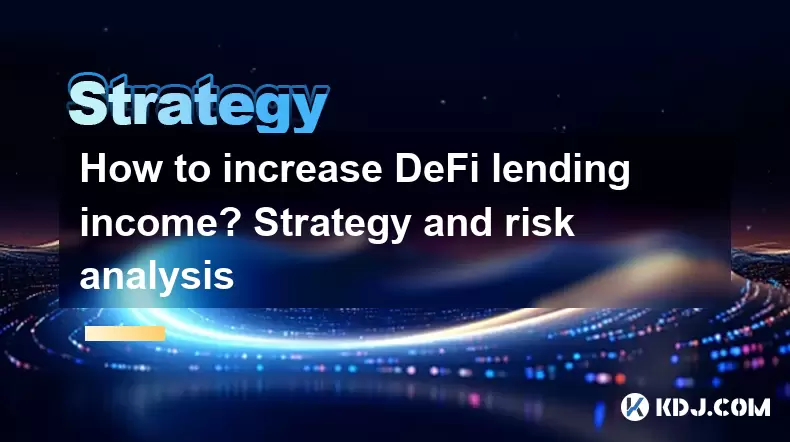-
 bitcoin
bitcoin $118548.520763 USD
3.67% -
 ethereum
ethereum $4352.564943 USD
4.79% -
 xrp
xrp $2.964058 USD
4.22% -
 tether
tether $1.000565 USD
0.05% -
 bnb
bnb $1028.372955 USD
1.46% -
 solana
solana $221.373507 USD
6.00% -
 usd-coin
usd-coin $0.999933 USD
0.02% -
 dogecoin
dogecoin $0.248633 USD
6.85% -
 tron
tron $0.341444 USD
2.38% -
 cardano
cardano $0.852946 USD
5.82% -
 hyperliquid
hyperliquid $47.869306 USD
6.15% -
 chainlink
chainlink $22.561476 USD
6.01% -
 ethena-usde
ethena-usde $1.001258 USD
0.05% -
 avalanche
avalanche $30.660000 USD
2.06% -
 stellar
stellar $0.400917 USD
9.76%
How to increase DeFi lending income? Strategy and risk analysis
DeFi lending lets users earn passive income by supplying crypto to smart contract platforms, with yields varying based on asset demand and market conditions.
Jun 24, 2025 at 02:08 pm

Understanding DeFi Lending and Its Income Potential
DeFi (Decentralized Finance) lending has emerged as a popular way to earn passive income in the cryptocurrency space. Unlike traditional banking systems, DeFi lending platforms allow users to lend their crypto assets directly to borrowers without intermediaries. The lenders earn interest based on the supply-demand dynamics of each asset. However, maximizing returns requires strategic planning and risk assessment.
The core idea behind DeFi lending is that liquidity providers deposit funds into smart contract-based protocols, which are then borrowed by others. In return, lenders receive interest payments, often denominated in stablecoins or platform-specific tokens. These yields can vary widely depending on the platform, asset, and market conditions.
Selecting High-Yield DeFi Platforms
Not all DeFi platforms offer the same returns or risks. To increase your lending income, it's crucial to evaluate and choose platforms with strong fundamentals, high liquidity, and transparent governance.
- Look for protocols with high total value locked (TVL), indicating robust usage and demand for borrowing.
- Check if the platform offers additional incentives like yield farming rewards or token airdrops.
- Consider platforms that provide variable interest rates alongside fixed ones to optimize returns during volatile periods.
Before locking in your funds, always research the team behind the project, its audit history, and community sentiment. Tools like DeFi Pulse or Dune Analytics can help you compare yields across different platforms.
Asset Selection: Stablecoins vs. Volatile Tokens
Choosing the right asset to lend is one of the most impactful decisions in maximizing DeFi lending income. While stablecoins like USDC or DAI typically offer lower but more predictable returns, volatile assets such as ETH or SOL may yield higher interest rates due to increased risk exposure.
- Lending stablecoins ensures consistent income without worrying about price swings.
- Lending volatile tokens can boost income significantly but exposes lenders to potential impermanent loss or collateral liquidation.
To balance risk and reward, consider diversifying your portfolio across both types of assets. Allocate a larger portion to stablecoins for stability and a smaller portion to high-risk/high-reward tokens for enhanced yield potential.
Leveraging Yield Aggregators and Multi-Chain Strategies
Yield aggregators like Yearn.finance or Beefy Finance automatically move funds between different DeFi protocols to capture the highest lending yields available. These platforms optimize returns by continuously monitoring and reallocating capital based on changing market conditions.
- Use automated vaults that compound interest regularly to maximize compounding effects.
- Explore multi-chain opportunities by deploying funds on different blockchains like Ethereum, Binance Smart Chain, or Avalanche where yields might be higher.
However, using these tools introduces additional smart contract risks. Always assess the security measures of the aggregator and ensure the underlying protocols have been audited and are well-established.
Risk Management and Mitigation Techniques
While increasing income is essential, managing risk exposure is equally important in DeFi lending. Smart contract vulnerabilities, market volatility, and regulatory changes can lead to significant losses if not properly addressed.
- Only use platforms with comprehensive audits from reputable firms like CertiK or PeckShield.
- Avoid overexposure to a single protocol or asset; diversify across multiple platforms and chains.
- Monitor collateralization ratios and liquidation thresholds when lending volatile assets.
Using decentralized insurance protocols like Nexus Mutual or InsurAce can also protect against unexpected losses from hacks or exploits. Staying informed through DeFi news channels and community forums helps anticipate and mitigate emerging threats.
Frequently Asked Questions
What happens if a borrower defaults on a DeFi loan?In most DeFi lending platforms, loans are over-collateralized. If a borrower fails to repay, their collateral is automatically liquidated to cover the lender’s funds. This process is governed by smart contracts and executed without human intervention.
Can I withdraw my funds anytime from a DeFi lending pool?Most platforms allow instant withdrawals, but some may impose withdrawal fees or require waiting periods during high congestion. Always check the specific terms of the protocol before depositing.
Is DeFi lending taxable?Yes, in many jurisdictions, DeFi lending income is considered taxable. Interest earned is typically treated as ordinary income, and capital gains taxes apply when converting or selling the earned tokens.
How do variable interest rates work in DeFi lending?Variable rates fluctuate based on supply and demand within the lending pool. When more people borrow an asset, its interest rate rises, encouraging more lenders to supply it. Conversely, if supply exceeds demand, rates drop.
Disclaimer:info@kdj.com
The information provided is not trading advice. kdj.com does not assume any responsibility for any investments made based on the information provided in this article. Cryptocurrencies are highly volatile and it is highly recommended that you invest with caution after thorough research!
If you believe that the content used on this website infringes your copyright, please contact us immediately (info@kdj.com) and we will delete it promptly.
- BlockDAG, DOGE, HYPE Sponsorship: Crypto Trends Shaping 2025
- 2025-10-01 00:25:13
- Deutsche Börse and Circle: A StableCoin Adoption Powerhouse in Europe
- 2025-10-01 00:25:13
- BlockDAG's Presale Buzz: Is It the Crypto to Watch in October 2025?
- 2025-10-01 00:30:13
- Bitcoin, Crypto, and IQ: When Genius Meets Digital Gold?
- 2025-10-01 00:30:13
- Stablecoins, American Innovation, and Wallet Tokens: The Next Frontier
- 2025-10-01 00:35:12
- NBU, Coins, and Crypto in Ukraine: A New Yorker's Take
- 2025-10-01 00:45:14
Related knowledge

Practical parameter settings for a Bitcoin multi-timeframe moving average system
Sep 18,2025 at 10:54pm
Optimizing Timeframe Combinations for Bitcoin Trading1. Selecting appropriate timeframes is crucial when building a multi-timeframe moving average sys...

How can I filter out false breakouts in Dogecoin high-frequency trading?
Sep 22,2025 at 01:00am
Understanding False Breakouts in Dogecoin Trading1. A false breakout occurs when Dogecoin's price appears to move beyond a defined support or resistan...

Techniques for identifying tops and bottoms in the Bitcoin on-chain NVT model
Sep 20,2025 at 07:54pm
Understanding the NVT Model in Bitcoin Analysis1. The Network Value to Transactions (NVT) ratio is often described as the 'P/E ratio' of the cryptocur...

What does the surge in open interest in Bitcoincoin futures mean?
Sep 20,2025 at 11:18pm
Understanding the Surge in Dogecoin Futures Open Interest1. A surge in open interest within Dogecoin futures indicates a growing number of active cont...

How can I use the Ethereum USDT premium to gauge market sentiment?
Sep 18,2025 at 11:55pm
Understanding the Ethereum USDT Premium1. The Ethereum USDT premium refers to the price difference between USDT (Tether) traded on Ethereum-based plat...

What should I do if Ethereum staking yields decline?
Sep 20,2025 at 06:18am
Understanding the Causes Behind Declining Ethereum Staking Yields1. The Ethereum network transitioned to a proof-of-stake consensus mechanism with the...

Practical parameter settings for a Bitcoin multi-timeframe moving average system
Sep 18,2025 at 10:54pm
Optimizing Timeframe Combinations for Bitcoin Trading1. Selecting appropriate timeframes is crucial when building a multi-timeframe moving average sys...

How can I filter out false breakouts in Dogecoin high-frequency trading?
Sep 22,2025 at 01:00am
Understanding False Breakouts in Dogecoin Trading1. A false breakout occurs when Dogecoin's price appears to move beyond a defined support or resistan...

Techniques for identifying tops and bottoms in the Bitcoin on-chain NVT model
Sep 20,2025 at 07:54pm
Understanding the NVT Model in Bitcoin Analysis1. The Network Value to Transactions (NVT) ratio is often described as the 'P/E ratio' of the cryptocur...

What does the surge in open interest in Bitcoincoin futures mean?
Sep 20,2025 at 11:18pm
Understanding the Surge in Dogecoin Futures Open Interest1. A surge in open interest within Dogecoin futures indicates a growing number of active cont...

How can I use the Ethereum USDT premium to gauge market sentiment?
Sep 18,2025 at 11:55pm
Understanding the Ethereum USDT Premium1. The Ethereum USDT premium refers to the price difference between USDT (Tether) traded on Ethereum-based plat...

What should I do if Ethereum staking yields decline?
Sep 20,2025 at 06:18am
Understanding the Causes Behind Declining Ethereum Staking Yields1. The Ethereum network transitioned to a proof-of-stake consensus mechanism with the...
See all articles










































































